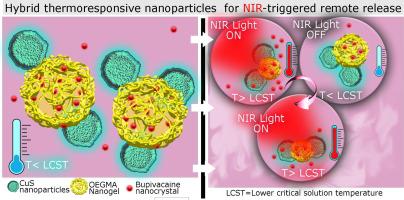Journal of Colloid and Interface Science ( IF 9.4 ) Pub Date : 2021-09-17 , DOI: 10.1016/j.jcis.2021.09.064 Teresa Alejo 1 , Victor Sebastian 2 , Gracia Mendoza 3 , Manuel Arruebo 2

|
The on-demand administration of anaesthetic drugs can be a promising alternative for chronic pain management. To further improve the efficacy of drug delivery vectors, high drug loadings combined with a spatiotemporal control on the release can not only relief the pain according to patient’s needs, but also improve the drawbacks of conventional burst release delivery systems. In this study, a hybrid nanomaterial was developed by loading bupivacaine nanocrystals (BNCs) into oligo(ethylene glycol) methyl ether methacrylate (OEGMA)-based thermoresponsive nanogels and coupling them to NIR-absorbing biodegradable copper sulphide nanoparticles (CuS NPs). Those CuS NPs were surface modified with polyelectrolytes using layer-by-layer techniques to be efficiently attached to the surface of nanogels by means of supramolecular interactions. The encapsulation of bupivacaine in the form of nanocrystals allowed to achieve CuS@BNC-nanogels having drug loadings as high as 65.5 wt%. The nanocrystals acted as long-lasting drug reservoirs, leading to an elevated localized drug content, which was useful for their application in prolonged pain relief. The CuS@BNC-nanogels exhibited favorable photothermal transducing properties upon NIR-light irradiation. The photothermal effect granted by the CuS NPs triggered the nano-crystallized drug release to be boosted by the collapse of the thermoresponsive nanogels upon heating. Remote control was achieved for on-demand release at a specific time and place, indicating their potential use as an externally activated triggerable drug-delivery system. Furthermore, cell viability tests and flow cytometry analysis were performed showing satisfactory cytocompatibility in the dose-ranging study having a subcytotoxic concentration of 0.05 mg/mL for CuS@BNC-nanogels. This remotely activated nanoplatform is a promising strategy for long-lasting controlled analgesia and a potential alternative for clinical pain management.
中文翻译:

用于近红外触发远程释放的含有药物纳米晶体的混合热响应纳米粒子
麻醉药物的按需给药可能是慢性疼痛管理的一个有前途的替代方案。为了进一步提高给药载体的疗效,高载药量结合释放的时空控制,不仅可以根据患者的需要缓解疼痛,还可以改善传统突释给药系统的缺点。在这项研究中,通过将布比卡因纳米晶体 (BNCs) 加载到基于低聚 (乙二醇) 甲基醚甲基丙烯酸酯 (OEGMA) 的热响应纳米凝胶中,并将它们与吸收 NIR 的可生物降解硫化铜纳米颗粒 (CuS NPs) 偶联,开发了一种混合纳米材料。这些 CuS NPs 使用聚电解质进行表面改性,使用逐层技术通过超分子相互作用有效地附着在纳米凝胶的表面。以纳米晶体形式包封布比卡因可以实现载药量高达 65.5% 的 CuS@BNC-纳米凝胶。纳米晶体充当持久的药物储库,导致局部药物含量升高,这有助于它们在长期镇痛中的应用。CuS@BNC-纳米凝胶在近红外光照射下表现出良好的光热转换性能。CuS NPs 赋予的光热效应触发了纳米结晶药物的释放,通过加热时热响应纳米凝胶的坍塌来促进纳米晶化药物的释放。在特定时间和地点实现了按需释放的远程控制,表明它们作为外部激活的可触发给药系统的潜在用途。此外,进行了细胞活力测试和流式细胞术分析,在剂量范围研究中显示出令人满意的细胞相容性,CuS@BNC-纳米凝胶的亚细胞毒性浓度为 0.05 mg/mL。这种远程激活的纳米平台是一种有前途的长期受控镇痛策略,也是临床疼痛管理的潜在替代方案。











































 京公网安备 11010802027423号
京公网安备 11010802027423号